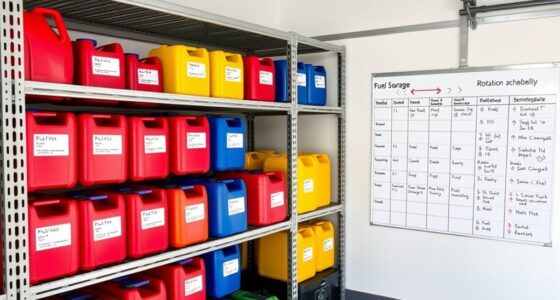To support elderly or special-needs family members, start by understanding their specific needs and creating a safe, accessible home with modifications like grab bars, ramps, or non-slip floors. Utilize community and government resources such as local agencies, support programs, and social activities. Focus on caregiver self-care to prevent burnout, and plan financially and legally for long-term care options. If you want to learn more about creating a all-encompassing support system, keep exploring these strategies.
Key Takeaways
- Assess their physical, cognitive, and emotional needs to tailor care and safety modifications effectively.
- Utilize community resources, support programs, and respite services to reduce caregiver stress and improve access.
- Develop comprehensive long-term care plans, including legal documents and financial strategies, to ensure ongoing support.
- Implement environmental adaptations and assistive devices to enhance safety and independence at home.
- Prioritize self-care and mental health for caregivers while maintaining organized communication with healthcare and support teams.
Understanding the Needs of Your Family Member

How can you accurately understand the needs of your family member? Start by evaluating their physical and cognitive abilities. If they struggle with at least two daily activities like dressing, bathing, or mobility, they may have a functional impairment requiring support. For those with cognitive or mental impairments, observe if they need supervision to prevent safety hazards. Veterans with high disability ratings often need continuous personal care, so understanding their specific needs is vital. Also, consider their emotional health—look for signs of anxiety, depression, or stress—and be prepared to address these. Regular health monitoring and environmental safety measures are essential, too. The Older Americans Act also provides resources and programs that can assist in assessing and meeting these needs. By thoroughly examining these areas, you can develop a tailored caregiving approach that respects their unique physical, mental, and emotional needs.
Exploring Available Community and Government Resources

Exploring community and government resources can substantially ease the caregiving journey by connecting you to essential support services. The Federal programs, like the National Family Caregiver Support Program, provide grants to help fund caregiver support, while the Eldercare Locator links you to local agencies and community organizations. The Family Caregiver Alliance and the National Alliance for Caregiving serve as central hubs for information, policy updates, and advocacy, offering valuable resources nationwide. At the state level, services like Minnesota’s Senior LinkAge Line and Disability HUB MN provide assistance with personal care, home-delivered meals, and living skills training, helping maintain independence. Community programs, such as inclusive recreation and social activities, foster connection and engagement for adults with disabilities, complementing specialized therapies and equipment resources to support your family member’s well-being. Additionally, eye patch benefits are often overlooked but can be helpful in promoting overall health and comfort for individuals with specific needs. Understanding projector technology can also be beneficial when choosing assistive devices that support sensory and visual needs, enhancing the overall quality of life. Incorporating puppy socialization strategies can further improve behavioral outcomes and emotional resilience for both pets and their owners, which can be especially helpful in caregiving environments. Recognizing the impact of dreaming techniques can further assist in developing mental resilience and emotional well-being for caregivers and family members alike.
Creating a Safe and Supportive Home Environment

Creating a safe and supportive home environment is essential for helping elderly or disabled family members maintain their independence and well-being. Start by making external modifications like widening doorways, installing ramps, automatic doors, and lifts to reduce fall risks. Inside, add grab bars, curbless showers, and offset controls to minimize bending and reaching, lowering injury chances. Non-slip flooring and better lighting also help prevent falls. Improve stair safety with railings and stair lifts, ensuring safer mobility indoors. These changes increase functional independence in daily activities like cooking and bathing, allowing your loved ones to stay in their familiar surroundings longer. Tailoring modifications to individual needs and conducting environmental assessments can optimize safety and support, ultimately enhancing quality of life. Home modifications have been shown to slow functional decline and reduce injury risk, making them a crucial part of comprehensive care. Additionally, incorporating assistive devices can further promote safety and independence at home. Recognizing the importance of AI in healthcare, such technologies can support these safety efforts by providing remote monitoring and personalized assistance. Implementing aesthetic solutions such as wall organization systems can also help reduce clutter and create a more manageable living space for those with mobility challenges. Incorporating space optimization strategies from bathroom renovation knowledge can help maximize available room for mobility aids and storage solutions.
Managing Caregiver Well-Being and Avoiding Burnout

Caring for elderly or disabled family members can be deeply rewarding, but it also poses significant challenges that can lead to stress and burnout. Many caregivers spend over 40 hours weekly providing unpaid care, often neglecting their own health. This relentless demand increases risks of mental health issues like anxiety and depression, with nearly 67% experiencing adverse symptoms. To prevent burnout, prioritize self-care, set boundaries, and seek support. Use the table below to identify common stressors and effective strategies:
| Stressor | Strategy |
|---|---|
| Care coordination difficulties | Regular communication with healthcare team |
| Financial concerns | Explore assistance programs |
| Access to respite care | Schedule regular breaks |
| Managing multiple providers | Maintain organized care plans |
| Personal health neglect | Schedule routine health checkups |
Additionally, understanding aura dynamics and visualizations can help caregivers stay aware of their own emotional and energetic balance, promoting overall well-being. Developing a regular practice of mindfulness can further support emotional resilience and reduce stress for caregivers. Incorporating self-care routines that address both physical and emotional needs is essential to sustain long-term caregiving efforts. Engaging in stress management techniques can also help caregivers better cope with daily challenges and maintain their mental health.
Planning for Long-Term Care and Financial Support

As the need for long-term care becomes increasingly probable with age, planning ahead is crucial to guarantee you or your loved ones receive appropriate support without overwhelming financial burdens. Long-term care can cost around $138,000 per person, with costs varying widely by location. Nearly 70% of older adults will need assistance with daily activities, and 25% may require care lasting three or more years. To prepare, explore insurance options like traditional or linked-benefit policies, which offer benefits ranging from hundreds of thousands to over half a million dollars. Consider inflation protection to maintain your benefits’ value over time. Funding can come from savings, family support, public programs like Medicaid, or hybrid insurance plans. Early planning ensures financial security and access to necessary care when it’s needed most. Additionally, understanding filial responsibility laws can help families plan for potential legal obligations related to elder support. Incorporating knowledge about Gold IRA Rollovers and other investment strategies can help safeguard assets and provide additional financial resources for long-term care expenses. Utilizing specialized long-term care insurance policies can further enhance financial planning by covering costs that exceed other funding sources. Being aware of power of attorney options can ensure that your chosen representative manages your affairs effectively if you become unable to do so.
Frequently Asked Questions
How Can I Navigate Complex Insurance and Medicaid Policies for Care?
You should start by researching your state’s specific Medicaid rules, including income and asset limits, home equity exemptions, and eligibility criteria. Keep detailed records of finances and medical needs, and consult with case managers or legal experts to navigate complex policies. Staying informed about policy changes, funding cuts, and waivers helps you make proactive decisions, ensuring your loved ones get the care they need without unnecessary delays or denials.
What Legal Documents Are Essential for Long-Term Caregiving Planning?
You need essential legal documents like a Durable Power of Attorney to manage finances if you’re incapacitated, a Healthcare Power of Attorney for medical decisions, and an Advance Directive to specify end-of-life preferences. A will or trust helps organize asset distribution and long-term care, while keeping these documents in a secure, accessible place ensures your wishes are honored and legal processes run smoothly during emergencies or future planning.
How Do I Balance Caregiving With My Personal and Employment Responsibilities?
To balance caregiving with your personal and work responsibilities, prioritize tasks and set clear boundaries. Communicate openly with your employer about your needs, taking advantage of flexible schedules and leave policies. Seek external support or respite care when needed, and don’t hesitate to ask family or friends for help. Remember to prioritize your health and well-being—self-care isn’t optional; it’s essential for sustained caregiving.
Are There Specific Programs Supporting Culturally Diverse or Underserved Communities?
Of course, there are programs tailored for culturally diverse and underserved communities—if you can find them. These initiatives recognize unique cultural norms, language barriers, and social challenges, offering culturally sensitive support, advocacy, and resources. They include community-based services, language-specific outreach, and policies inclusive of diverse family structures. Seek out local organizations, healthcare providers, and national coalitions that focus on these communities; your loved ones deserve care that respects their identity.
How Can I Effectively Communicate With Healthcare Providers and Service Agencies?
To communicate effectively with healthcare providers and service agencies, come prepared with detailed medical histories, questions, and notes. Use clear, simple language, speak slowly, and employ visual aids if needed. Confirm understanding by paraphrasing information. Attend appointments regularly, share insights about the patient’s routines, and respect their autonomy. Keep documentation organized, use electronic records when possible, and advocate for your loved one’s needs to guarantee smooth, respectful interactions.
Conclusion
Supporting elderly or special-needs family members can be challenging, but it’s incredibly rewarding. Remember, over 60% of caregivers experience stress, yet many find fulfilling ways to provide care and comfort. By understanding their needs, utilizing resources, and taking care of yourself, you can make a meaningful difference. Your dedication not only improves their quality of life but also strengthens your family bonds. Keep going—your support truly matters and can transform lives.










